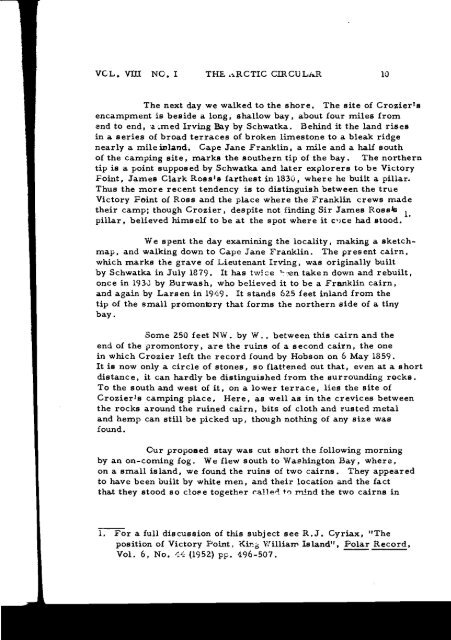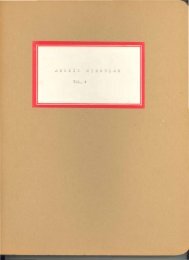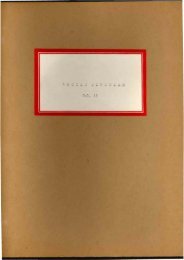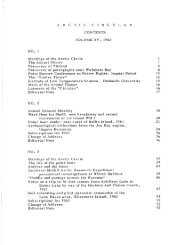Volume 8, 1955 - The Arctic Circle - Home
Volume 8, 1955 - The Arctic Circle - Home
Volume 8, 1955 - The Arctic Circle - Home
- No tags were found...
You also want an ePaper? Increase the reach of your titles
YUMPU automatically turns print PDFs into web optimized ePapers that Google loves.
VGL. VIII NO. I THE. .... RCTIC ClRCULiLR 10<strong>The</strong> next day we walked to the shore. <strong>The</strong> site of Croziertsencampment is beside a long, shallow bay, about four miles fromend to end, "01 ~med Irving Bay by Schwatka. Behind it the land risesin a series of broad terraces of broken limestone to a bleak ridgenearly a mileizll-and. Cape Jane Franklin. a mile and a half southof the camping site, marks the southern tip of the bay. <strong>The</strong> northerntip is a point supposed by Schwatka and later explorers to be VictoryFoint, James Clark Ross's farthest in 1830, where he built a pillar.Thus the more recent tendency is to distinguish between the trueVictory Foint of Ross and the place where the Franklin crews madetheir camp: though Crozier, despite not finding Sir James Rossls 1.pillar. believed himself to be at the spot where it C'lee had stood.We spent the day examining the locality, making a sketchmap,and walking down to Cape Jane Franklin. <strong>The</strong> present cairn.which marks the grave of Lieutenant Irving, was originally builtby Schwatka in July 1879. It has twice "oen taken down and rebuilt,once in 19313 by Burwash, who believed it to be a Franklin cairn,and again by Larsen in 1949. It stands 625 feet inland from thetip of the small promon1Dry that forms the northern side of a tinybay.Some 250 feet NW. by W., between this cairn and theend of the promontory, are the ruins of a second cairn, the onein which Crozier left the record found by Hobson on 6 May 1859.It is now only a circle of stones. so flattened out that, even at a shortdistance, it can hardly be distinguished from the surrounding rocks.To the south and west of it. on a lower terrace, lies the site ofCrozier's camping place. Here. as well as in the crevices betweenthe rocks around the ruined cairn. bits of cloth and rusted metaland hemp can still be picked up, though nothing of any size wasfound.Our proposed stay was cut short the following morningby an on-coming fog. We flew south to Washington Bay, where.on a small island, we found the ruins of two cairns. <strong>The</strong>y appearedto have been built by white men, and their location and the factthat they stood so clope together ra]]er1. t') mind the two cairns in1. For a full discussion of this subject see R.J. Cyriax, "<strong>The</strong>position of Victory Point, Kir-i; VrillialT' Island". Polar Record.Vol. 6. No. "'''' (l952) Pl". 496-507.












